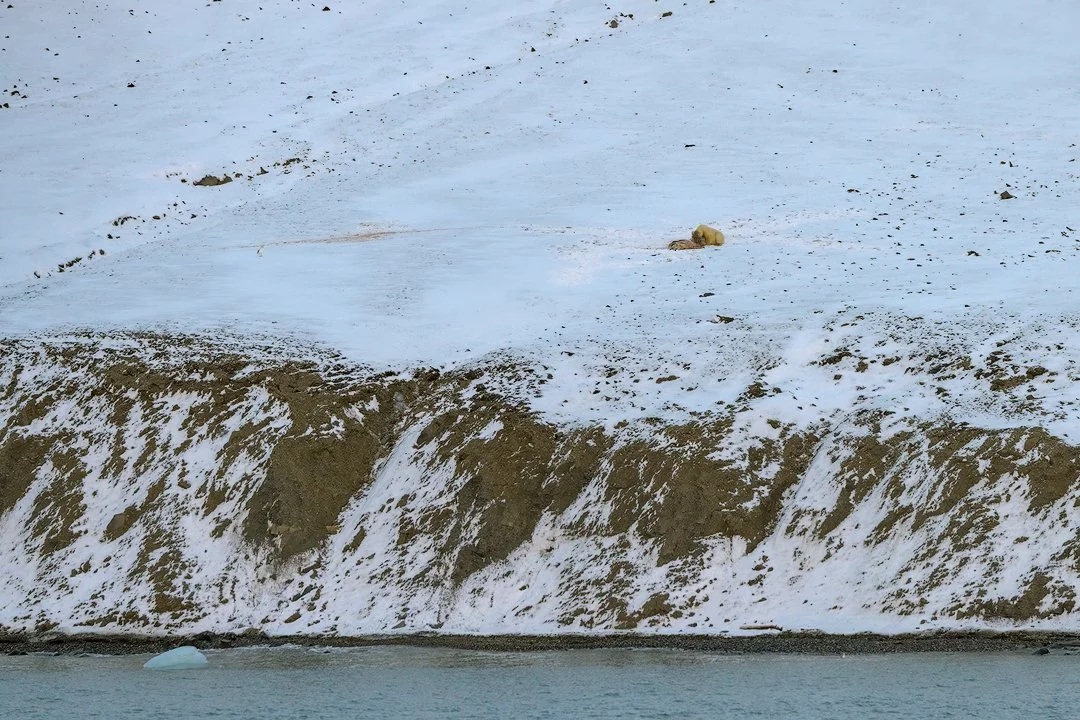The Bear and The Net (Revisited)
Last year Polar Bears International published a story I wrote about an encounter I had with a polar bear deep in the pack ice north of Svalbard in the high Arctic, north of Norway. During that encounter, which lasted for over two hours, there was a moment when the bear, a five year solitary female, suddenly emerged from the icy water draped in a heavy fishing net. Those of us watching her from the boat felt helpless, knowing that there was nothing we could do to help her. But she did managed to free herself and hopefully continues today to wander the pack ice in search of ring seals (a polar bear’s preferred repast).
That experience brought to light for me the issue of what is called “ghost gear” or abandoned fishing gear that travels around the world on the ocean currents entangling all manner of dolphins, whales and other species. Polar bears suffering from net entanglements has not been widely documented, perhaps because of the remoteness of where they live, and the lack of human observers to document such cases.
This past September I returned to the area to observe and document the high Arctic and its residents in the fall, when the days were growing shorter, the sun hanging lower in the sky, and the light resplendent with soft pinks and yellows.
And as fate would have it, I came across another situation where a polar bear was interacting with an abandoned fishing net.
As our small ship (the M/S Stockholm) slowly approached a polar bear that the crew had spotted from some distance away, we realized that the bear was not only feeding on a reindeer carcass, but that the reindeer’s horns were thoroughly entangled in another heavy fishing net.
Our concern over whether the bear would inadvertently consume pieces of the net as it fed on the carcass led naturally to asking the question: what exactly has happened here, how did the reindeer, the bear and an abandoned fishing net all come together at this particular moment among the fjords of Spitsbergen (one of Svalbard’s largest islands).
We can only speculate but we do know a few things: that global warming has been shown to cause rapidly rising temperatures in the waters surrounding Svalbard, which means that the fjords are no longer consistently freezing over during the winter; that this is cutting off the natural migration routes between the islands of the Svalbard archipelago of the resident reindeer and polar bears alike; that large kelp forests have started to move into and populate the increasingly ice-free fjords; that as they have been denied access to their traditional grazing areas the reindeer are beginning to feed on the kelp that washes ashore; that polar bears, either by choice or by necessity, have begun to feed more frequently on the reindeer; and that reindeer have been observed rubbing their antlers (to remove the velvet in preparation for the rutting season) on fishing nets and gear that has collected along the shore, in some cases getting their antlers caught in the nets.
So what do we think happened? Again, this is only speculation but it is likely that the reindeer was along the shore feeding on kelp and got tangled in the net, which has washed up on shore, later to be discovered by a wandering polar bear who may or may not have then dragged the reindeer several meters up the step slop away from the water’s edge.
Svalbard lies at the northern terminus of the Gulf Stream which may account for how ghost gear ends up there in its waters and along its shores. This experience with the reindeer and the bear highlights the dangers ghost gear presents to Arctic wildlife. The fact that I witnessed one such event—and a year later a second—suggests these interactions may be far more common than previously understood. We might be seeing only the tip of the proverbial iceberg.




